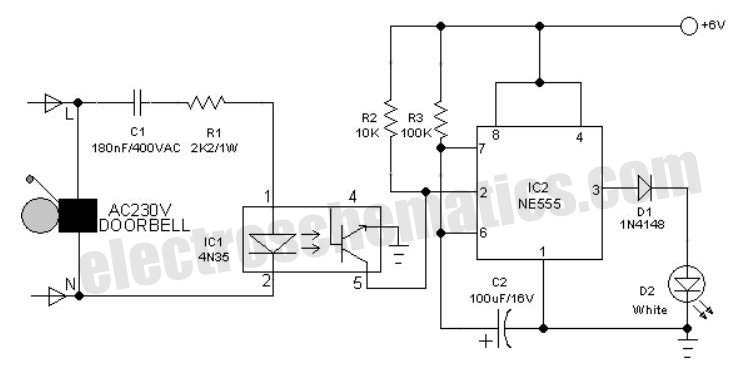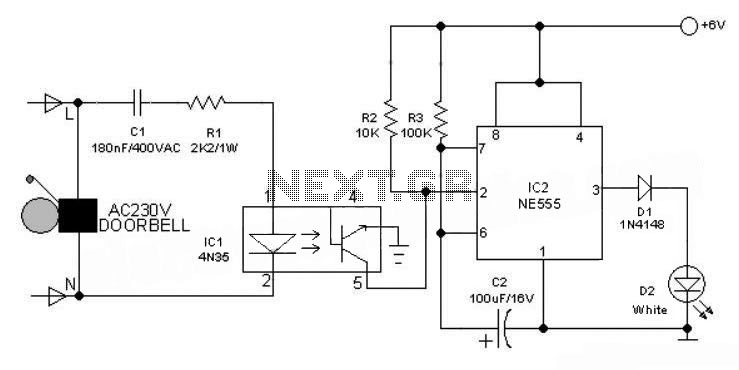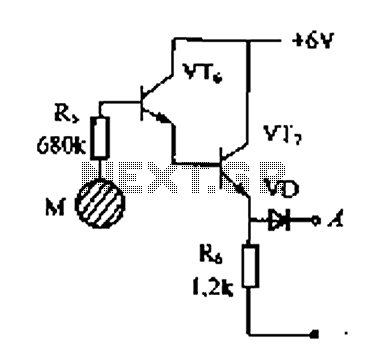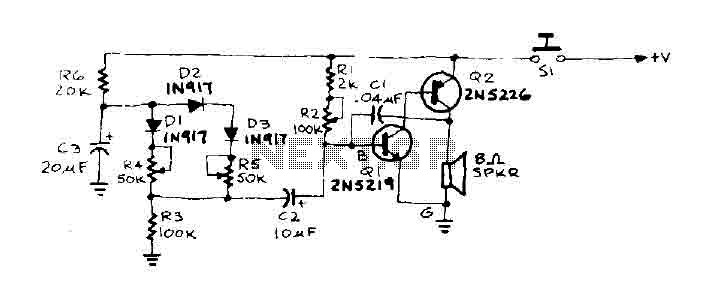
Doorbell with IC555
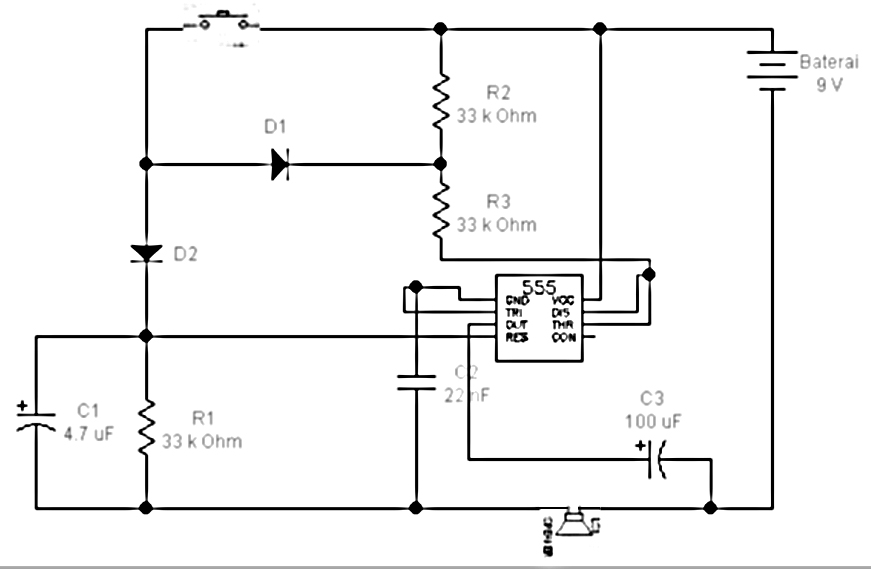
All components are arranged as depicted in the sequence below. Current will flow from the source voltage to the switch. When the switch is closed, current will flow through the diode, which acts as a closed switch due to the forward bias applied (the anode of the diode receives positive voltage, while the cathode is given negative voltage). The current will then be split into two paths, directed towards D1 and D2. The flow from D1 (diode 1) will be channeled to R3 and subsequently to IC555 pin 7 and pin 6. Pin 7 (Discharge) functions as the timing interval for an audible tone, while pin 6 (Threshold) determines the final timing tone. The flow at D2 will be divided into three paths, leading to polar capacitors, resistors, and IC555 pin 4. Polar capacitors are characterized by their polarity. The current through the capacitor and R1 will connect to the positive terminal of the speaker. IC555 pin 4 serves as a reset, allowing the timing interval to be interrupted by applying a reset pulse of 0V. Pin 4 is also connected to the positive terminal of the speaker. The negative terminal of the speaker will be connected to C3 (capacitor 3) and grounded, while the negative probe of the speaker will connect to the negative source voltage. The operational principle of the Bel 2 tone involves supplying a DC voltage source to the IC555, which functions as a tone timer, utilizing the switch to select between a high tone (when the switch is ON) and a low tone (when the switch is OFF).
The circuit described utilizes a 555 timer integrated circuit (IC555) configured in astable mode to generate audio tones. In this arrangement, the switch serves as a control element to toggle between two distinct frequencies. When the switch is closed, the circuit is activated, allowing current to flow from the power source through the diode. The diode is crucial in ensuring that current only flows in one direction, thus protecting the circuit components from potential reverse polarity damage.
Current flowing through D1 is directed towards a resistor (R3) and then into pins 6 and 7 of the IC555. Pin 7 discharges the timing capacitor, influencing the frequency of the generated tone, while pin 6 monitors the voltage across the timing capacitor to determine when to reset the timing cycle. The division of current at D2 into three paths allows for additional components, such as polar capacitors, to shape the audio output. The inclusion of polar capacitors ensures that the circuit maintains the required voltage levels for proper operation.
The reset functionality provided by pin 4 of the IC555 is essential for controlling the timing intervals. By applying a reset pulse of 0V to this pin, the timing cycle can be interrupted, allowing the user to modify the output tone as needed. The connection of the speaker to the output of the IC555 enables the audible tone to be produced, with the negative terminal of the speaker grounded through C3 to complete the circuit.
Overall, this circuit exemplifies a simple yet effective method for generating audio tones using a 555 timer IC, with the switch facilitating user control over the tone frequency. The careful arrangement of components ensures reliable operation and clear sound output.All components arranged as in the picture sequence below. Current will flow starting from the sourcevoltage and to the switch. When the switch is closed current will flow through the diode, wherediode serves as a switch is closed because it was given forward bias (anode diode is givenpositive voltage and the cathode is given a negative voltage). F lows will be divided into two to D1 andD2. Flows from D1 (diode 1) will be channeled towards R3 and proceed toward IC555 pin7 andpin 6. Pin 7 (Discharge) serves as an audible tone interval timing, and pin 6 (threshold) to determine the final timing tone, flow at D2 will be divided into three, headingpolar capacitors, resistors, and IC555 pin 4. Polar capacitors are capacitors that havepoles. The current through the capacitor and R1 polar probe + will go to the speakers. IC555 pin 4is reset, as the timing interval can be interrupted by giving the reset pulse 0V. IC555pin 4 is connected to the speaker probe +. Speaker probe - will be connected with C3(capacitor 3) and grounded out, and the probe - the speakers will be connected with the sourcevoltage -.
The working principle of the Bel 2 tone in which the DC voltage source is given in the IC555serves as a timer tones, and used the switch that serves as a voter tonehigh (when the switch is turned ON) and low tone (when the switch position OFF). 🔗 External reference
The circuit described utilizes a 555 timer integrated circuit (IC555) configured in astable mode to generate audio tones. In this arrangement, the switch serves as a control element to toggle between two distinct frequencies. When the switch is closed, the circuit is activated, allowing current to flow from the power source through the diode. The diode is crucial in ensuring that current only flows in one direction, thus protecting the circuit components from potential reverse polarity damage.
Current flowing through D1 is directed towards a resistor (R3) and then into pins 6 and 7 of the IC555. Pin 7 discharges the timing capacitor, influencing the frequency of the generated tone, while pin 6 monitors the voltage across the timing capacitor to determine when to reset the timing cycle. The division of current at D2 into three paths allows for additional components, such as polar capacitors, to shape the audio output. The inclusion of polar capacitors ensures that the circuit maintains the required voltage levels for proper operation.
The reset functionality provided by pin 4 of the IC555 is essential for controlling the timing intervals. By applying a reset pulse of 0V to this pin, the timing cycle can be interrupted, allowing the user to modify the output tone as needed. The connection of the speaker to the output of the IC555 enables the audible tone to be produced, with the negative terminal of the speaker grounded through C3 to complete the circuit.
Overall, this circuit exemplifies a simple yet effective method for generating audio tones using a 555 timer IC, with the switch facilitating user control over the tone frequency. The careful arrangement of components ensures reliable operation and clear sound output.All components arranged as in the picture sequence below. Current will flow starting from the sourcevoltage and to the switch. When the switch is closed current will flow through the diode, wherediode serves as a switch is closed because it was given forward bias (anode diode is givenpositive voltage and the cathode is given a negative voltage). F lows will be divided into two to D1 andD2. Flows from D1 (diode 1) will be channeled towards R3 and proceed toward IC555 pin7 andpin 6. Pin 7 (Discharge) serves as an audible tone interval timing, and pin 6 (threshold) to determine the final timing tone, flow at D2 will be divided into three, headingpolar capacitors, resistors, and IC555 pin 4. Polar capacitors are capacitors that havepoles. The current through the capacitor and R1 polar probe + will go to the speakers. IC555 pin 4is reset, as the timing interval can be interrupted by giving the reset pulse 0V. IC555pin 4 is connected to the speaker probe +. Speaker probe - will be connected with C3(capacitor 3) and grounded out, and the probe - the speakers will be connected with the sourcevoltage -.
The working principle of the Bel 2 tone in which the DC voltage source is given in the IC555serves as a timer tones, and used the switch that serves as a voter tonehigh (when the switch is turned ON) and low tone (when the switch position OFF). 🔗 External reference
Warning: include(partials/cookie-banner.php): Failed to open stream: Permission denied in /var/www/html/nextgr/view-circuit.php on line 713
Warning: include(): Failed opening 'partials/cookie-banner.php' for inclusion (include_path='.:/usr/share/php') in /var/www/html/nextgr/view-circuit.php on line 713
